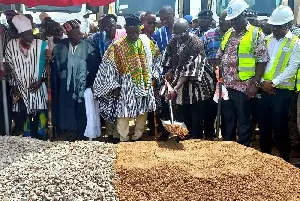Phase one construction of the 83-kilometre Savelugu-Walewale road, which is a part of Ghana’s trunk road system’s Central Corridor that runs from Accra, Ghana’s capital, to the country’s northern parts has begun following a groundbreaking ceremony carried out by Dr Mahamudu Bawumia the vice president of the West African country.
It is said that the road was initially an important link between the country and its landlocked neighbours (Burkina Faso, Mali, and Niger) as well as for the transportation of cargo to and from these countries from Ghana’s ports.
The Eastern Corridor, which connects Tema, Asikuma, Hohoe, Bimbilla, Yendi, Gushegu, Gbintiri, Bunkprugu, Garu, Bawku, and Polimakom, and the Western Corridor, which connects Elubo-Enchie, Goaso, Sunyani, Techiman, Bole, Wa, Lawra, Nandom, and Hamile, were the major road corridors.
Also Read: Latest Developments on Keta Sea Port Project, Ghana
Projets being carried out on the central, eastern and western corridors
A number of road projects are being undertaken on the central, eastern and western corridors, according to Vice President Dr Mahamudu Bawumia, who cut sod to commence construction work on the Savelugu-Walewale road.
He said that the Tema-Akosombo section was under construction, as well as the Tamale-Paga Road which was originally built in 1991 with funding from the Japanese government’s Japan International Cooperation Agency (JICA).
He added that the road within the town is expected to be dualized with the appropriate safety measures and that the Walewale-Nalerigu crossing would be upgraded separately into an interchange.
Some of the completed and ongoing projects, he added, included the asphalt overlay of 100 kilometres of roads in the Northern, North East, and Savanah Regions, with beneficiaries being Nalerigu, Walewale, Gambaga, Damongo, Yendi, and Tamale.
Savelugu-Walewale road benefits to the economy
Dr Bawumia emphasized the road’s economic importance, noting that the government has made huge efforts to improve various sections of the country’s roads through maintenance interventions.
The project’s mission, according to the Vice President, was to improve ultra-urban, regional, and national trade; strengthen regional economic integration; and lower the country’s cost of operating business.

